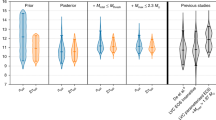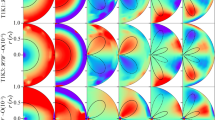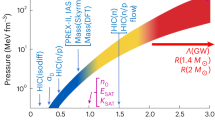Abstract
STRONGLY magnetized neutron stars are believed to be at the heart of a number of astrophysical systems, notably pulsars and X-ray binaries. Although the magnetic field is an important determinant in the behaviour of such systems, the origin and stability of the field is the subject of conflicting observational and theoretical evidence. Here I describe a new model of neutron-star magnetic moments, by which the fields are generated as the neutron star is born, and follow the evolution of the field over a Hubble time. With realistic thermal evolution and conductivities, isolated neutron stars will maintain large magnetic fields for more than 1010 years. In addition, I show how mass accretion on to neutron stars can reduce the field strength1,2. This model of field generation and decay can explain a wide variety of observed systems.
This is a preview of subscription content, access via your institution
Access options
Subscribe to this journal
Receive 51 print issues and online access
$199.00 per year
only $3.90 per issue
Buy this article
- Purchase on Springer Link
- Instant access to full article PDF
Prices may be subject to local taxes which are calculated during checkout
Similar content being viewed by others
References
Taam, R. E. & van den Heuvel, E. P. J. Astrophys. J. 305, 235–245 (1986).
Shibazaki, N., Murakami, T., Shaham, J. & Nomoto, K. Nature 342, 656–658 (1989).
Narayan, R. & Ostriker, J. P. Astrophys. J. 352, 222–246 (1990).
Blandford, R. D., Applegate, J. H. & Hernquist, L. Mon. Not. R. astr. Soc. 204, 1025–1048 (1983).
Lyne, A. G., Manchester, R. N. & Taylor, J. H. Mon. Not R. astr. Soc. 213, 613–639 (1985).
Kulkarni, S. R. Astrophys. J. 306, L85–L89 (1986).
Murakami, T. et al. Nature 335, 234–235 (1988).
Baym, G., Pethick, C. & Pines, D. Nature 224, 674–67 (1969).
Sang, Y. & Chanmugan, G. Astrophys. J. 323, L61–L64 (1987).
Tsuruta, S. Proc. 13th Texas Symp. on Relativistic Astrophysics (ed. Ulmer, M.) 499–503 (World Scientific, Singapore, 1987).
Hernquist, L. & Applegate, J. H. Astrophys. J. 287, 244–254 (1984).
Baym, G., Pethick, C. J. & Sutherland, P. Astrophys. J. 170, 299–317 (1971).
Buchler, J. R. & Barkat, Z. Astrophys. Lett. 7, 167–170 (1971).
Shibazaki, N. & Lamb, R. K. Astrophys. J. 346, 808–822 (1989).
Ostriker, J. P. & Gunn, J. E. Astrophys. J. 157, 1395–1417 (1969).
Flowers, E. & Itoh, N. Astrophys. J. 206, 218–241 (1976).
Yakovlev, D. G. & Urpin, V. A. Soviet Astr. 24, 303–310 (1980).
Flowers, E. & Ruderman, M. A. Astrophys. J. 215, 302–310 (1977).
Blandford, R. D. & Romani, R. W. Mon. Not R. astr. Soc. 234, 57P–60P (1988).
Bailes, M. Astrophys. J. 342, 917–927 (1989).
de Kool, M. & van Paradijs, J. Astr. Astrophys. 173, 279–283 (1986).
Romani, R. W. Astrophys. J. 357, 493–501 (1990).
Blondin, J. M. & Freese, K. Nature 323, 786–788 (1986).
Ghosh, P. & Lamb, F. K. Astrophys. J. 234, 296–316 (1979).
Author information
Authors and Affiliations
Rights and permissions
About this article
Cite this article
Romani, R. A unified model of neutron-star magnetic fields. Nature 347, 741–743 (1990). https://doi.org/10.1038/347741a0
Received:
Accepted:
Issue Date:
DOI: https://doi.org/10.1038/347741a0
This article is cited by
-
A discovery of two slow pulsars with FAST: “Ronin” from the globular cluster M15
Science China Physics, Mechanics & Astronomy (2024)
-
Searches for continuous-wave gravitational radiation
Living Reviews in Relativity (2023)
-
Revisiting Field Burial by Accretion onto Neutron Stars
Journal of Astrophysics and Astronomy (2017)
-
Magneto–Thermal Evolution of Neutron Stars with Emphasis to Radio Pulsars
Journal of Astrophysics and Astronomy (2017)
-
Magnetic Fields of Neutron Stars
Journal of Astrophysics and Astronomy (2017)
Comments
By submitting a comment you agree to abide by our Terms and Community Guidelines. If you find something abusive or that does not comply with our terms or guidelines please flag it as inappropriate.



